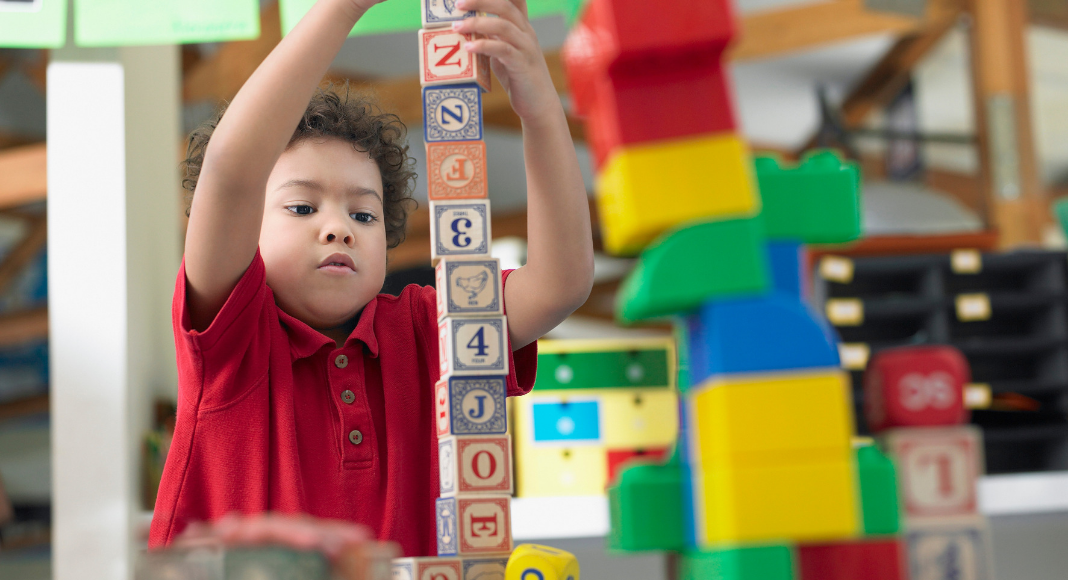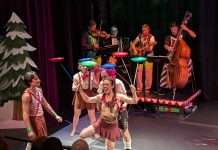
Moving your toddler from an infant-based daycare or nanny-care is a big step for parents. Not only is it an exciting time of change, but it means your baby is growing up! It’s also a time of serious consideration for the type of preparation you want your child to have before entering kindergarten.
Science is teaching us about the importance of play and social learning in toddlerhood. As such, many parents are choosing to enroll their child in play-based environments where there is less focus on traditional learning and more focus on free-play and social interaction. During back-to-school, often there is more focus in the media on the child’s lunch box options than there is on the child and preparing them for being successful in their new learning environment. But, making the effort to prepare your child for a play-based preschool or daycare will help them have the best experience possible. Here are a few ways to help them prepare:
Phase your child into time away from you.
A caregiver with 6+ toddlers to care for is not the best environment for your child to learn to be away from home. When children are learning to be in the care of someone else besides their parents, it often brings up a lot of emotions for the child and the parents. When this happens for the first time in a classroom or group of students this can cause the entire group to lose a day or even a month of calm play. But worse, the child won’t be able to be given as much care and attention as they might need during this emotional time. If your toddler has never been away from you, invest in a kind and open-minded nanny or share care at least a couple of months before your child plans to start their toddler program. If the nanny can slowly increase the time away, even better! This process will help the toddler to learn that when their parents are away, they will still be cared for, and they will be returned to the parents after some time away. Taking this step will help your child’s transition to a toddler-based program go more smoothly and allow them to worry less about being away from home and focus more on playing and gaining social skills.
Dress your child for play.
So much of play is a physical expression. Dress your child for comfortable movement. When toddlers play they run, hop, crawl, and move their bodies in every way they know is possible. If your child’s program goes outdoors, which I hope they do, even more consideration is required. Think, “How can I help my child dress in clothing that allows her to move freely and feel comfortable in the elements?” One area where children’s fashion often lets us down is shoes. Try to find shoes that your child can run and climb in. Consider comfort, support, and breathability as well as style.
Encourage self-expression.
The things that your child brings with them to school are often the items they draw on to connect with other children and display their sense of identity. Let your child choose a backpack that fits their body well and a water bottle with a pattern that they love. Children get so much delight from showing each other everything about themselves from the dinosaur on their t-shirt to the rocket ship on their water bottle. They love when other children are similar and they love when someone has something new and different from their own, so allow that uniqueness. It leads to conversation, friendship, and confident individuality.
Play is messy.
Toddlers make messes and get dirty. It’s nothing a good bath and load of laundry can’t fix. So, let your child explore in the mud, at the sandbox, and wherever else their intuition takes them, provided it’s safe to do so. Toddlers play through the interaction with materials in the world and often find rocks or bugs that surprise them, make them giggle, and create bonding memories with their friends. Let them explore a bit with you so that they do not feel ashamed or averse to getting a bit messy when playing at school.
Be prepared for the ups and downs of play.
When toddlers play together a lot can happen. Sometimes Johny will take Sally’s toy and there will be tears and the two kiddos will need a caregiver to help them navigate who should play with the toy next. Sometimes, kids play blissfully for long-periods of time without conflict. And, sometimes, kids get hurt.
Toddlers don’t seek out bruises, but sometimes they are trying out something new and hurt themselves. Sometimes, when playing together they bump bodies or objects and get a boo-boo. This is all part of healthy play and the process of learning about their bodies and how to respectfully and safely play with other children. Your child will learn so much through these interactions but expect a few bumps and bruises along the way. Trust that your caregiver is doing their best to keep your child safe but that children also need to be allowed to play together and explore the boundaries of their bodies and interactions with others.
Toddlers learn so much through play and social interaction. Reflecting on the items above as areas to focus on when preparing your child for their play-based program will help set them up for success. Remember that the best way for your child to learn about play is to play at home and with their peers. Start playing more with your child and help them learn the skills they need to interact with others once they begin socializing more in their play-based program.






















